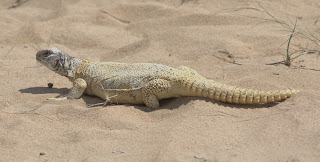 |
| Masked Owl |
We spent a couple of weeks visiting four national parks in north-east NSW for three nights each that we’d missed in the past. First off was the Cypress Pine Campground in Boonoo Boonoo National Park (below), just across the Queensland border. The park adjoins Queensland’s Girraween National Park.
Much better facilities here (generally the case with NSW versus Queensland parks) and nice big camp sites. Platypus was seen frequently in the creek below the camp but the only image was the poor effort below of one swimming past a Little Pied Cormorant.
We had lousy weather here with a couple of days of rain. A pair of Scarlet Robins (below) around the camp lifted spirits.
We also had large numbers of big moths coming into our lights at night, notwithstanding the appalling weather. We wondered if they might be the celebrated Bogong Moths on their return migration from further south.
We did a day trip to the nearby Basket Swamp National Park and found 3 Spotted Quail-thrush – a pair (below) and a single male – in different spots. We visited the hideout of the famous bushranger Captain Thunderbolt during a quick visit to Tenterfield.
We moved on to Cathedral Rock National Park where the Native Dog Campground was our home for 3 freezing nights: at 1250m the temperature dropped to -5. Nice scenery, but this was one of many areas hit badly by the 2019-20 bushfires. It was disturbing not to find any mammals despite some serious looking with the thermal imager; not even a Common Brushtail about the camp. Just a single Superb Lyrebird was heard when they should have been calling all over the place.
Birds were making a comeback, however. Honeyeaters were in good numbers, with White-eared and Brown-headed showing nicely.
 |
| Brown-headed Honeyeater |
 |
| White-eared Honeyeater |
Red-browed Treecreeper (below) appeared to be surprisingly common and was found feeding with White-throated Treecreeper in a couple of spots.
Other showy offerings included Striated Thornbill and Crimson Rosella.
 |
| Crimson Rosella |
 |
| Striated Thornbill |
Forest Raven and Bassian Thrush were present in good numbers.
 |
| Forest Raven |
 |
| Bassian Thrush |
Next stop was Nymboi-Binderay National Park near Dorrigo where we camped at Platypus Flat campground (below). A beautiful spot overlooking the river, handicapped somewhat by the absence of walking tracks.
A male Masked Owl feeding in the picnic ground was the stand-out here.
It had plenty to feed on. Bush Rat (below) was abundant, both in the scrub and open campground areas. Although this area was hit by the fires, they were limited to about 4m above ground so large trees were largely unscathed, and pockets of ground cover appeared to have escaped the flames.
I was surprised to find both Northern Short-nosed and Southern Long-nosed Bandicoots feeding in the campground.
 |
| Southern Long-nosed Bandicoot |
 |
| Northern Short-nosed Bandicoot |
Paradise Riflebird and Red-bellied Black Snake were among other critters about.
 |
| Paradise Riflebird |
 |
| Red-bellied Black Snake |
We moved on to Moonee Beach for a couple of days at one of our favourite coastal destinations. Of interest here was a pair of Beach Stone-Curlews (below). A few days later I saw another pair of Beach Stone-Curlews flying around at dusk further north at Pottsville. The following day I found 3 Beach Stone-Curlews 4km away at Hastings Point on Cudgera Creek: 3 sightings at 3 sites of this supposedly rare species in NSW within a few days.
Our final national park was Rummery Park Campground in Whian Whian State Conservation Area (below). Here our high expectations of NSW national parks suffered a setback: it was horribly overcrowded on the Saturday night we were there, though okay on other nights.
A pair of Marbled Frogmouths were near the camp, while up the road were a couple of Tawny Frogmouths, including a brown phase bird.
 |
| Marbled Frogmouth |
 |
| Tawny Frogmouth |
Pale-yellow Robin was a constant present around our caravan. Three Albert’s Lyrebirds were heard at different spots. An Australian Logrunner was found at its night roost.
 |
| Australian Logrunner |
 |
| Pale-yellow Robin |
We finished up with a couple of nights at Pottsville. Other than the above-mentioned Beach Stone-Curlews, Bush Stone-Curlew (below) appeared to be all over the place, which was something of a surprise.








































